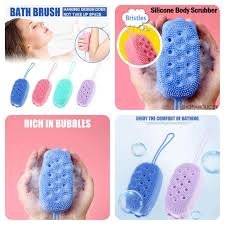How to Sanitize a Silicone Body Scrubber
Learn how to sanitize a silicone body scrubber effectively with easy steps for daily and deep cleaning. Keep your scrubber fresh, hygienic, and long-lasting.

Silicone body scrubbers are growing in popularity due to their durability, gentle exfoliation, and resistance to bacterial growth. Compared to traditional loofahs or sponges, silicone scrubbers are far more hygienic. However, even though they’re made of non-porous material, these scrubbers still need regular cleaning and sanitizing to stay safe and effective.
Whether you're using one in the shower or for skincare, keeping your scrubber clean is essential for healthy skin and overall hygiene. In this article, we’ll guide you step-by-step on how to sanitize your silicone body scrubber and explain why it's just as important to know how to clean silicone body scrubber as it is to use it correctly.
Why Sanitize Your Silicone Body Scrubber?
Silicone scrubbers come into contact with sweat, body oils, dead skin cells, and soap every day. Over time, these substances can accumulate in the bristles and base, creating an environment where bacteria may begin to grow — especially if the scrubber is not rinsed and dried properly.
Although silicone is less likely to harbor germs compared to natural fibers, it's not immune. Sanitizing your scrubber helps eliminate any lingering bacteria, mold spores, and mildew, which not only keeps your skin safe but also extends the life of your body scrubber.
How Often Should You Sanitize It?
The frequency depends on how often you use the scrubber. For most people:
-
Daily users: Rinse and air dry after each use; sanitize once a week.
-
Occasional users: Sanitize every 2–3 weeks.
-
Shared use: Sanitize every few days to prevent cross-contamination.
Even if the scrubber looks clean, invisible bacteria can still be present. Sanitizing it weekly as a habit ensures maximum cleanliness.
Supplies You’ll Need
Sanitizing a silicone body scrubber doesn’t require special cleaning agents. Most of the things you need are already in your home:
-
Warm water
-
White vinegar
-
Baking soda (optional for deodorizing)
-
Mild dish soap or body wash
-
A clean toothbrush or small brush
-
Microwave-safe bowl or small pot (for hot water soak)
These basic items will help you sanitize your scrubber without damaging the silicone material.
Step-by-Step: How to Sanitize a Silicone Body Scrubber
1. Rinse and Scrub First
Before sanitizing, you should start with a basic clean. This step ensures that any soap scum or skin debris is removed, allowing the sanitizer to reach all surfaces.
-
Rinse the scrubber under warm running water.
-
Use a toothbrush or small scrubber to gently clean between the silicone bristles.
-
Add a few drops of mild soap and work it in thoroughly.
-
Rinse clean and shake off any excess water.
This is a good example of how to clean silicone body scrubber before moving on to the sanitization step.
2. Hot Water Soak
One of the simplest ways to sanitize silicone is by using hot water. Silicone is heat-resistant (unless stated otherwise by the manufacturer), making it safe for this method.
-
Bring a pot of water to a boil and remove it from heat.
-
Place the scrubber in the hot water and let it soak for 5–10 minutes.
-
Carefully remove it using tongs and let it cool on a clean towel.
This method kills most common germs and is very effective when done weekly.
3. Vinegar Soak for Natural Disinfection
White vinegar is a natural antibacterial agent that’s safe for skin contact. It also helps dissolve soap residue and eliminates odors.
-
Mix equal parts warm water and white vinegar in a bowl.
-
Submerge your scrubber completely and let it soak for 10–15 minutes.
-
Rinse well afterward with warm water and allow it to dry completely.
You can also sprinkle in a teaspoon of baking soda for a gentle fizzing action that helps deodorize and lift grime. This is another great example of how to clean silicone body scrubber while adding an effective sanitizing step.
4. Microwave Steam (Only If Safe)
Some silicone scrubbers are microwave-safe — but check the label first.
-
Place the scrubber in a microwave-safe bowl with water.
-
Microwave on high for 1–2 minutes.
-
Let it cool before removing it.
The steam created in the microwave helps kill bacteria, making it a quick and effective sanitation method. However, always verify heat resistance before using this method.
5. Dry It Thoroughly
After sanitizing, drying your silicone body scrubber is crucial. Leaving it damp in a humid bathroom can lead to mold growth, even on silicone.
-
Shake off excess water.
-
Air dry in a well-ventilated area or hang it where air can circulate.
-
Avoid storing it in closed containers or areas that don’t allow proper airflow.
Moisture is the enemy of hygiene when it comes to any bath tool — even one made from silicone.
When to Replace Your Silicone Scrubber
Even with excellent cleaning habits, your silicone scrubber won’t last forever. Over time, the bristles may lose flexibility, or the material may degrade slightly. Replace your scrubber if:
-
It has a persistent odor even after cleaning.
-
The silicone becomes sticky, brittle, or discolored.
-
There are visible cracks or damage.
Most silicone scrubbers last between 6 months to a year with regular sanitizing. Replacing it periodically ensures optimal performance and hygiene.
Final Thoughts
Sanitizing your silicone body scrubber is a simple but essential part of maintaining healthy skin and avoiding the buildup of harmful bacteria. Whether you’re using hot water, vinegar, or mild soap, regularly disinfecting your scrubber will keep it clean, safe, and effective.
Knowing how to clean silicone body scrubber and combining that with proper sanitization gives you the best of both worlds: a scrubber that’s gentle on your skin and tough on germs. Add this habit to your regular self-care routine, and your skin — and your scrubber — will thank you.
What's Your Reaction?


















